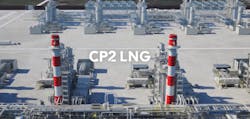Venture Global Says Yes to $15.1B CP2 LNG Terminal Construction
Liquified natural gas (LNG) export developer Venture Global will move ahead with plans to build a $15 billion liquefaction and terminal along the Louisiana Gulf coast.
Venture Global has reached the final investment decision to close on the $15.1 billion in total financing for the first phase of the company’s third LNG project, the CP2. Once operational, CP2 could process 14 million tons of LNG per year to start and ultimately as much as 28 tons per year, adding to the U.S. status as the world’s top exporter.
Work on CP2 proceeds in tandem with the associated CP Express Pipeline. Natural gas is moved from shale plays to the Gulf when it’s liquified by chilling it to minus 260 degrees Fahrenheit and made stable for shipping.
The U.S. already rose to the top of LNG export nations prior to his second election, but President Trump has been actively supportive of expanding the nation's capacity of natural gas both for domestic and global supply purposes.
“We are extremely proud to have taken FID on our third greenfield project in under 6 years with over $80 billion in capital markets transactions executed to date,” said Venture Global CEO Mike Sabel in a statement. “This success would not be possible without the dedication and relentless execution of the entire Venture Global team. Our significant early investments and work on the project make CP2 the most advanced project at FID to date. This project, fully owned by Venture Global and our shareholders, is expected to deliver reliable American LNG to the world beginning in 2027.”
Phase 1 of CP2 LNG already has long-term purchase agreements with customers in Europe, Asia and the rest of the world. Venture Global now has a total contracted capacity of 43.5 MTPA across all three of its projects in Louisiana.
The company’s other LNG facilities include Plaquemines and Calcasieu Pass, also built along the Louisiana Gulf coast.
Project financing on CP2 is touted as the largest yet in the company’s LNG export buildout, according to Venture Global. The lender group for the construction financing includes Bank of America, Barclays, Bayern LB, BBVA, CIBC, Deutsche Bank, FirstBank, Flagstar, Goldman Sachs, Helaba, ICBC, ING, Intesa, J.P. Morgan, LBBW, Mizuho, MUFG, Natixis, NBC, Nord LB, Raymond James, RBC, Regions, Santander, Scotiabank, SMBC, Standard Chartered, Truist and Wells Fargo.
ING and Santander served as Lead Arrangers for CP2 LNG Phase 1’s Construction Term Loan and Working Capital Facility, while Bank of America and Scotiabank served as Lead Arrangers for CP2 LNG Phase 1’s Equity Bridge Loan. Latham & Watkins LLP served as counsel to Venture Global and Skadden, Arps, Slate, Meagher & Flom LLP served as counsel to lenders across all facilities.
Exponential production growth out of the nation’s shale plays this century has pushed the U.S. into the top LNG exporter position. As of April, U.S. export terminals have shipped LNG cargo to 48 other nations on five continents, according to the U.S. Department of Energy.
Current U.S. LNG export capacity is about 15 billion cubic feet of natural gas per day, according to the DOE. The largest export terminal currently operational is at Sabine Pass, owned and operated by Cheniere Energy, which produces 4.55 billion cubic feet per day.
About the Author
EnergyTech Staff
Rod Walton is senior editor for EnergyTech.com. He has spent 17 years covering the energy industry as a newspaper and trade journalist.
Walton formerly was energy writer and business editor at the Tulsa World. Later, he spent six years covering the electricity power sector for Pennwell and Clarion Events. He joined Endeavor and EnergyTech in November 2021.
He can be reached at [email protected].
EnergyTech is focused on the mission critical and large-scale energy users and their sustainability and resiliency goals. These include the commercial and industrial sectors, as well as the military, universities, data centers and microgrids.
Many large-scale energy users such as Fortune 500 companies, and mission-critical users such as military bases, universities, healthcare facilities, public safety and data centers, shifting their energy priorities to reach net-zero carbon goals within the coming decades. These include plans for renewable energy power purchase agreements, but also on-site resiliency projects such as microgrids, combined heat and power, rooftop solar, energy storage, digitalization and building efficiency upgrades.
